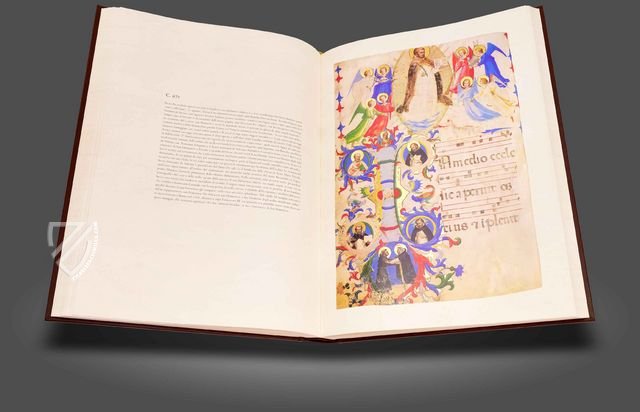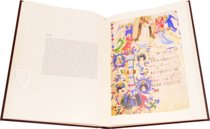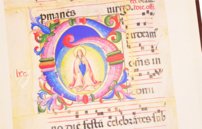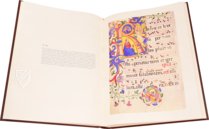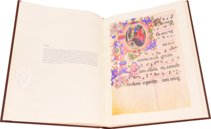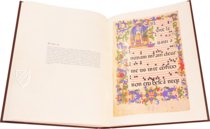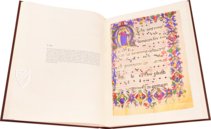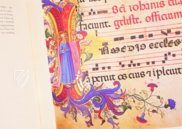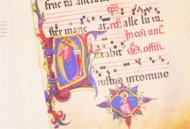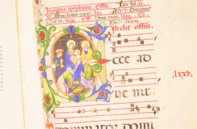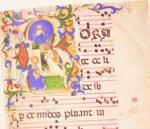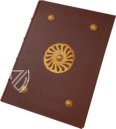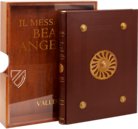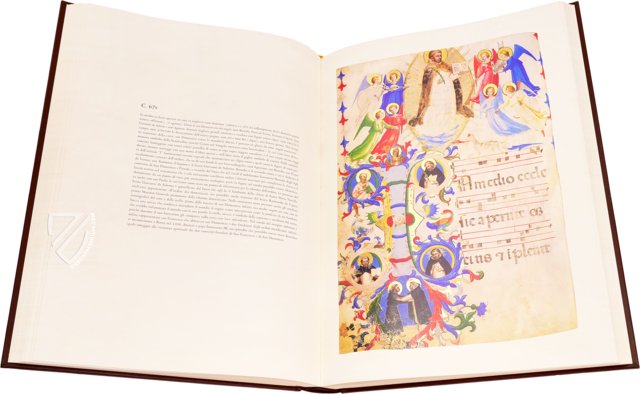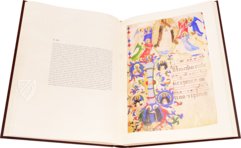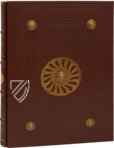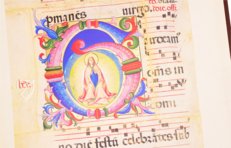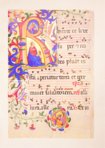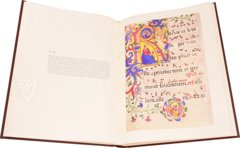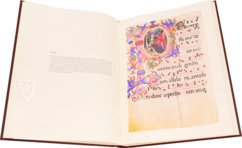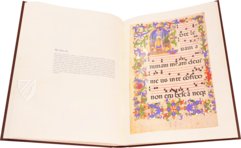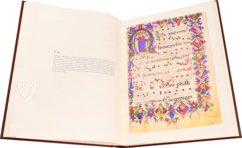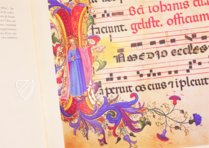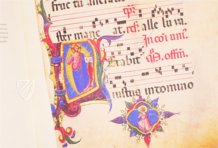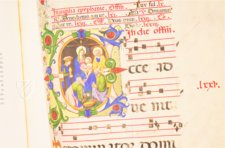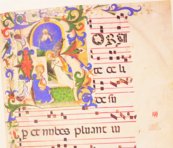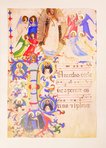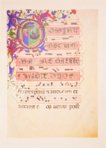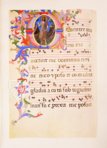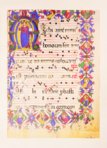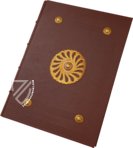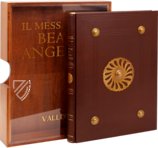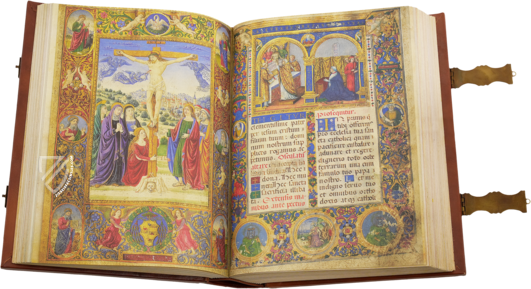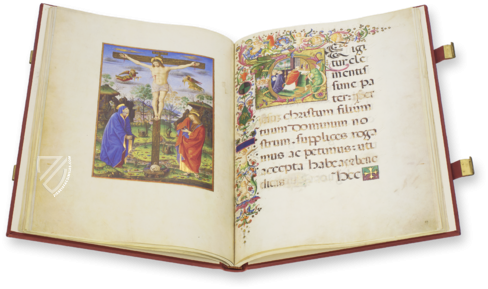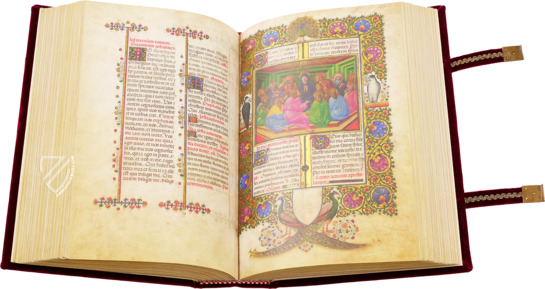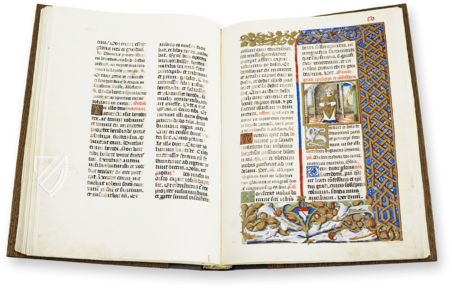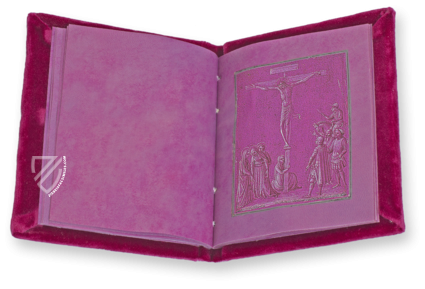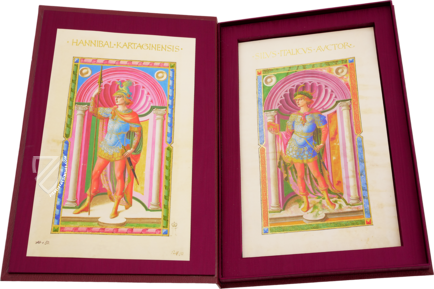Beato Angelico's Missal
The so-called Missal of Fra Beato Angelico is a luxurious prime example of Quattrocento book illumination in Florence. The missal, which contains the Ordinary of the mass as well as the prayers and hymns for the Christian feast days, was adorned with 51 striking miniatures in rich colors and precious gold, beautiful historiated initials and magnificent borders by two leading artists of the early Italian Renaissance: Fra Angelico and Zanobi Strozzi, his most talented pupil according to Vasari. Fra Angelico, also known as Beato Angelico, was a Dominican monk in the Convent of San Domenico in Fiesole, where the artful manuscript was created. The patron saint of the order and convent, St. Dominic, is accordingly given a special status, which is reflected in an extraordinarily sublime miniature. Fra Angelico and Zanobi Strozzi created an incomparable Quattrocento masterpiece that captivates with its opulent illuminations, vibrant colors and the great artistry of its masters.
Beato Angelico's Missal
The so-called Missal of Fra Angelico presents the illumination of the Florentine Quattrocento in outstanding quality: from the hand of the main representative of the early Florentine Renaissance, Fra Angelico, and his most gifted student, Zanobi Strozzi. Liturgical hymns for the various saints’ holidays were illustrated in numerous outstanding miniatures. The focus lay thereby on St. Dominic, the patron saint of the manuscript’s intended destination: the Convent of San Domenico in Fiesole, wherein the Dominican Monk lived from 1420 onward.
The Leading Master of the Early Florentine Renaissance
Fra Angelico (before 1400–1455), also known as Beato Angelico in Italian, is one of the big names of Italian Renaissance painting. He entered the Dominican Order as Giovanni da Fiesole. From 1420 onward, we was active in the Dominican Convent of San Domenico in Fiesole, and later in the Covent of San Marco in Florence. There, Fra Angelico decorated the walls of the cloister and other rooms with grandiose paintings. Additionally, he was also active as an illuminator, several manuscripts from his hand have survived. One of which is the gorgeous missal from the Convent of San Domenico in Fiesole, originating in the years 1424–1430.
The Gifted Student
40 miniatures in the manuscript came from Fra Angelico, eleven more from Zanobi Strozzi, a student of the painting Dominican monk. Zanobi Strozzi (1412–1468) originated from the genteel Florentine Strozzi family, producing both panel paintings and miniatures and was active as an artist for the Medici inter alia. He was identified by Giorgio Vasari in his Lives of the Most Excellent Painters, Sculptors, and Architects as Fra Angelico’s most talented student.
Remarkable Composition
The miniatures in Beato Angelico’s Missal give a wonderful overview of Florentine illumination at the beginning of the Quattrocento. The grandiose play with form and space characterizes the compositions and indicates the masterfulness of the painter. The paintings illustrate the hymns for the feast days of various saints. Saint Dominic – patron saint of the convent – is surrounded by musical angels, and is depicted in an exceedingly colorful scene. Fantastical flowers, vines, and similar, lavish ornamentation adorn the manuscript alongside depictions of the saints in large initials. As a synthesis of the arts, the missal is presented in exuberant luster and in the full glory of the fantastic art of the early Florentine Renaissance!
Codicology
- Alternative Titles
- Il Messale del Beato Angelico
Graduale di San Domenico
The San Domenico Missal
Missale des Fra Beato Angelico - Size / Format
- 522 pages / 47.5 × 35.3 cm
- Origin
- Italy
- Date
- 1424–1430
- Epochs
- Style
- Genre
- Language
- Script
- Gothic Textura
- Illustrations
- 51 miniatures, numerous historiated initials and magnificent borders
- Content
- Missal
- Artist / School
- Beato Angelico (illuminator)
Zanobi Strozzi (illuminator)
Probably Benedetto dal Mugello (scribe)
Beato Angelico's Missal
Annunciation to Mary
This beautiful, ivory-colored initial 'R' on a gold background shows the Annunciation in its inner compartment: With a book on her lap, Mary sits in a lovely garden while the Holy Spirit, sent by God the Father in heaven, comes upon her. At the same time, she is terrified by the approaching archangel Gabriel, who will reveal to her the miracle of her virgin pregnancy.
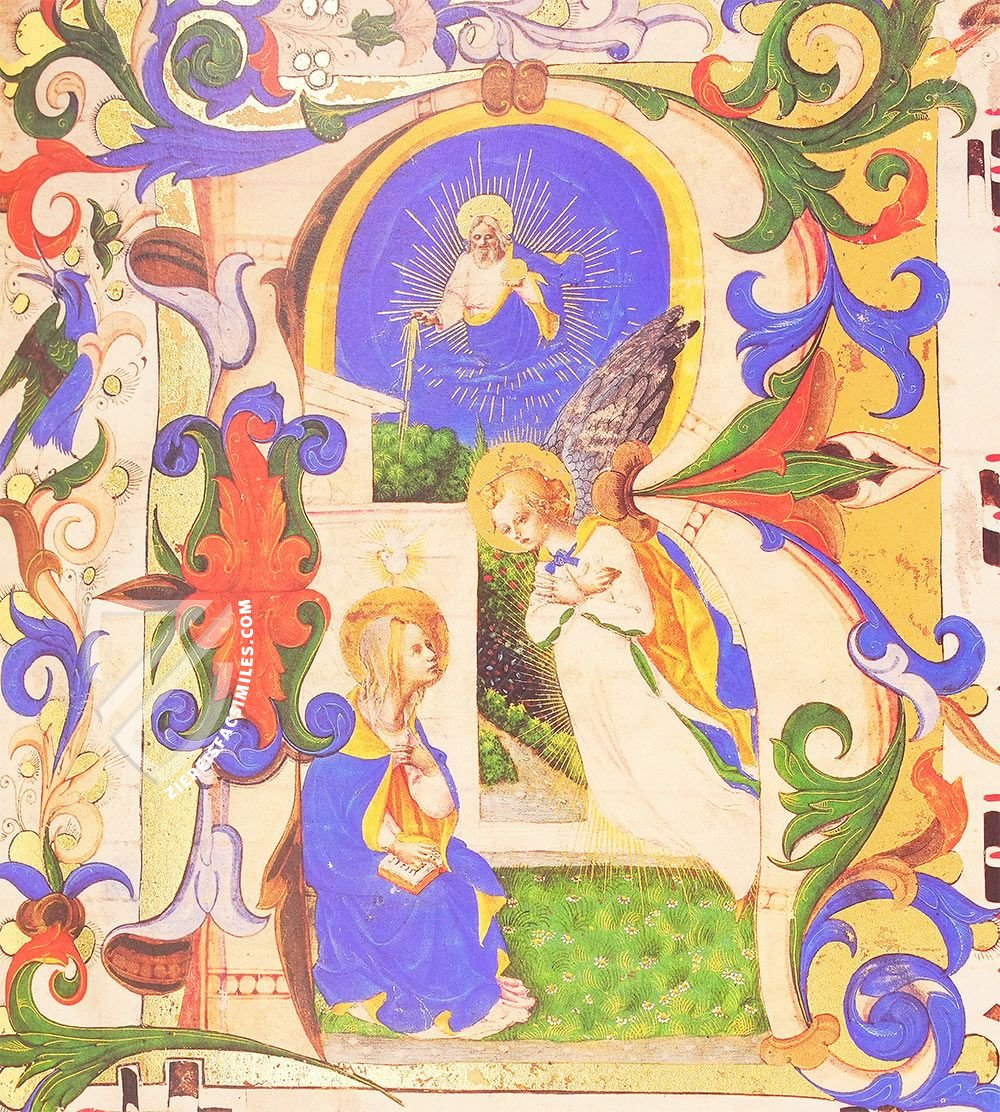
Beato Angelico's Missal
Saint Dominic
This splendid page introduces one of the liturgical hymns of the missal. The upper third is taken up by a sublime depiction of St. Dominic, who appears in a mandorla surrounded by angels making music. His holiness and veneration is enhanced by the golden halo of rays that surrounds him. Blue clouds at his feet visualize that he has already entered the heavenly kingdom. The patron saint wears the habit of the Dominicans, a white scapular and a black cope, while he presents an open book to the angels – perhaps a self-referential representation of the missal?
The text of the hymn, neatly written on parchment, begins with an exuberantly illuminated initial I, which almost drowns out the text and the accompanying notes. The opulent tendrils of the initial form a total of six medallions in which other saints, some also in Dominican habit, appear against blue backgrounds. The friendly embrace between the two monks in the lower medallion is striking: a Franciscan on the left and a Dominican on the right.
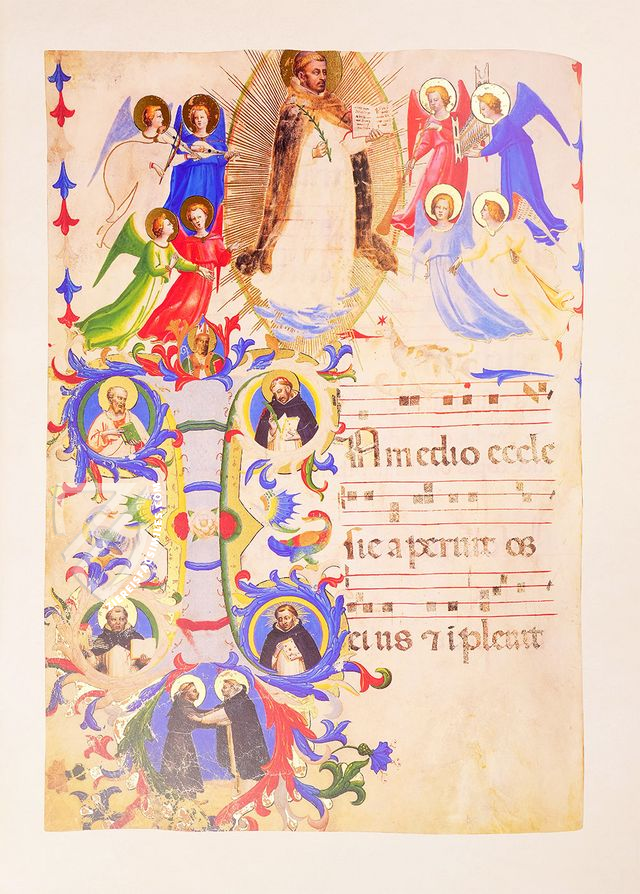
#1 Messale del Beato Angelico
Language: Italian
- Treatises / Secular Books
- Apocalypses / Beatus
- Astronomy / Astrology
- Bestiaries
- Bibles / Gospels
- Chronicles / History / Law
- Geography / Maps
- Saints' Lives
- Islam / Oriental
- Judaism / Hebrew
- Single Leaf Collections
- Leonardo da Vinci
- Literature / Poetry
- Liturgical Manuscripts
- Medicine / Botany / Alchemy
- Music
- Mythology / Prophecies
- Psalters
- Other Religious Books
- Games / Hunting
- Private Devotion Books
- Other Genres
- Afghanistan
- Armenia
- Austria
- Belgium
- Belize
- Bosnia and Herzegovina
- China
- Colombia
- Costa Rica
- Croatia
- Cyprus
- Czech Republic
- Denmark
- Egypt
- El Salvador
- Ethiopia
- France
- Germany
- Greece
- Guatemala
- Honduras
- Hungary
- India
- Iran
- Iraq
- Israel
- Italy
- Japan
- Jordan
- Kazakhstan
- Kyrgyzstan
- Lebanon
- Liechtenstein
- Luxembourg
- Mexico
- Morocco
- Netherlands
- Palestine
- Panama
- Peru
- Poland
- Portugal
- Romania
- Russia
- Serbia
- Spain
- Sri Lanka
- Sweden
- Switzerland
- Syria
- Tajikistan
- Turkey
- Turkmenistan
- Ukraine
- United Kingdom
- United States
- Uzbekistan
- Vatican City
- A. Oosthoek, van Holkema & Warendorf
- Aboca Museum
- Ajuntament de Valencia
- Akademie Verlag
- Akademische Druck- u. Verlagsanstalt (ADEVA)
- Aldo Ausilio Editore - Bottega d’Erasmo
- Alecto Historical Editions
- Alkuin Verlag
- Almqvist & Wiksell
- Amilcare Pizzi
- Andreas & Andreas Verlagsbuchhandlung
- Archa 90
- Archiv Verlag
- Archivi Edizioni
- Arnold Verlag
- ARS
- Ars Magna
- ArtCodex
- AyN Ediciones
- Azimuth Editions
- Badenia Verlag
- Bärenreiter-Verlag
- Belser Verlag
- Belser Verlag / WK Wertkontor
- Benziger Verlag
- Bernardinum Wydawnictwo
- BiblioGemma
- Biblioteca Apostolica Vaticana (Vaticanstadt, Vaticanstadt)
- Bibliotheca Palatina Faksimile Verlag
- Bibliotheca Rara
- Boydell & Brewer
- Bramante Edizioni
- Bredius Genootschap
- Brepols Publishers
- British Library
- C. Weckesser
- Caixa Catalunya
- Canesi
- CAPSA, Ars Scriptoria
- Caratzas Brothers, Publishers
- Carus Verlag
- Casamassima Libri
- Centrum Cartographie Verlag GmbH
- Chavane Verlag
- Christian Brandstätter Verlag
- Circulo Cientifico
- Club Bibliófilo Versol
- Club du Livre
- CM Editores
- Collegium Graphicum
- Collezione Apocrifa Da Vinci
- Comissão Nacional para as Comemorações dos Descobrimentos Portugueses
- Coron Verlag
- Corvina
- CTHS
- D. S. Brewer
- Damon
- De Agostini/UTET
- De Nederlandsche Boekhandel
- De Schutter
- Deuschle & Stemmle
- Deutscher Verlag für Kunstwissenschaft
- DIAMM
- Droz
- E. Schreiber Graphische Kunstanstalten
- Ediciones Boreal
- Ediciones Grial
- Ediclube
- Edições Inapa
- Edilan
- Editalia
- Edition Deuschle
- Edition Georg Popp
- Edition Leipzig
- Edition Libri Illustri
- Editiones Reales Sitios S. L.
- Éditions de l'Oiseau Lyre
- Editions Medicina Rara
- Editorial Casariego
- Editorial Mintzoa
- Editrice Antenore
- Editrice Velar
- Edizioni Edison
- Egeria, S.L.
- Eikon Editores
- Electa
- Emery Walker Limited
- Enciclopèdia Catalana
- Eos-Verlag
- Ephesus Publishing
- Ernst Battenberg
- Eugrammia Press
- Extraordinary Editions
- Fackelverlag
- Facsimila Art & Edition
- Facsimile Editions Ltd.
- Facsimilia Art & Edition Ebert KG
- Faksimile Verlag
- Feuermann Verlag
- Folger Shakespeare Library
- Franco Cosimo Panini Editore
- Friedrich Wittig Verlag
- Fundación Hullera Vasco-Leonesa
- G. Braziller
- Gabriele Mazzotta Editore
- Gebr. Mann Verlag
- Gesellschaft für graphische Industrie
- Getty Research Institute
- Giovanni Domenico de Rossi
- Giunti Editore
- Graffiti
- Grafica European Center of Fine Arts
- Guido Pressler
- Guillermo Blazquez
- Gustav Kiepenheuer
- H. N. Abrams
- Harrassowitz
- Harvard University Press
- Helikon
- Hendrickson Publishers
- Henning Oppermann
- Herder Verlag
- Hes & De Graaf Publishers
- Hoepli
- Holbein-Verlag
- Houghton Library
- Hugo Schmidt Verlag
- Idion Verlag
- Il Bulino, edizioni d'arte
- ILte
- Imago
- Insel Verlag
- Insel-Verlag Anton Kippenberger
- Instituto de Estudios Altoaragoneses
- Instituto Nacional de Antropología e Historia
- Introligatornia Budnik Jerzy
- Istituto dell'Enciclopedia Italiana - Treccani
- Istituto Ellenico di Studi Bizantini e Postbizantini
- Istituto Geografico De Agostini
- Istituto Poligrafico e Zecca dello Stato
- Italarte Art Establishments
- Jan Thorbecke Verlag
- Johnson Reprint Corporation
- Josef Stocker
- Josef Stocker-Schmid
- Jugoslavija
- Karl W. Hiersemann
- Kasper Straube
- Kaydeda Ediciones
- Kindler Verlag / Coron Verlag
- Kodansha International Ltd.
- Konrad Kölbl Verlag
- Kurt Wolff Verlag
- La Liberia dello Stato
- La Linea Editrice
- La Meta Editore
- Lambert Schneider
- Landeskreditbank Baden-Württemberg
- Leo S. Olschki
- Les Incunables
- Liber Artis
- Library of Congress
- Libreria Musicale Italiana
- Lichtdruck
- Lito Immagine Editore
- Lumen Artis
- Lund Humphries
- M. Moleiro Editor
- Maison des Sciences de l'homme et de la société de Poitiers
- Manuscriptum
- Martinus Nijhoff
- Maruzen-Yushodo Co. Ltd.
- MASA
- Massada Publishers
- McGraw-Hill
- Metropolitan Museum of Art
- Militos
- Millennium Liber
- Müller & Schindler
- Nahar - Stavit
- Nahar and Steimatzky
- National Library of Wales
- Neri Pozza
- Nova Charta
- Oceanum Verlag
- Odeon
- Orbis Mediaevalis
- Orbis Pictus
- Österreichische Staatsdruckerei
- Oxford University Press
- Pageant Books
- Parzellers Buchverlag
- Patrimonio Ediciones
- Pattloch Verlag
- PIAF
- Pieper Verlag
- Plon-Nourrit et cie
- Poligrafiche Bolis
- Presses Universitaires de Strasbourg
- Prestel Verlag
- Princeton University Press
- Prisma Verlag
- Priuli & Verlucca, editori
- Pro Sport Verlag
- Propyläen Verlag
- Pytheas Books
- Quaternio Verlag Luzern
- Reales Sitios
- Recht-Verlag
- Reichert Verlag
- Reichsdruckerei
- Reprint Verlag
- Riehn & Reusch
- Roberto Vattori Editore
- Rosenkilde and Bagger
- Roxburghe Club
- Salerno Editrice
- Saltellus Press
- Sandoz
- Sarajevo Svjetlost
- Schöck ArtPrint Kft.
- Schulsinger Brothers
- Scolar Press
- Scrinium
- Scripta Maneant
- Scriptorium
- Shazar
- Siloé, arte y bibliofilia
- SISMEL - Edizioni del Galluzzo
- Sociedad Mexicana de Antropología
- Société des Bibliophiles & Iconophiles de Belgique
- Soncin Publishing
- Sorli Ediciones
- Stainer and Bell
- Studer
- Styria Verlag
- Sumptibus Pragopress
- Szegedi Tudomànyegyetem
- Taberna Libraria
- Tarshish Books
- Taschen
- Tempus Libri
- Testimonio Compañía Editorial
- Thames and Hudson
- The Clear Vue Publishing Partnership Limited
- The Facsimile Codex
- The Folio Society
- The Marquess of Normanby
- The Richard III and Yorkist History Trust
- Tip.Le.Co
- TouchArt
- TREC Publishing House
- TRI Publishing Co.
- Trident Editore
- Tuliba Collection
- Typis Regiae Officinae Polygraphicae
- Union Verlag Berlin
- Universidad de Granada
- University of California Press
- University of Chicago Press
- Urs Graf
- Vallecchi
- Van Wijnen
- VCH, Acta Humaniora
- VDI Verlag
- VEB Deutscher Verlag für Musik
- Verlag Anton Pustet / Andreas Verlag
- Verlag Bibliophile Drucke Josef Stocker
- Verlag der Münchner Drucke
- Verlag für Regionalgeschichte
- Verlag Styria
- Vicent Garcia Editores
- W. Turnowski Ltd.
- W. Turnowsky
- Waanders Printers
- Wiener Mechitharisten-Congregation (Wien, Österreich)
- Wissenschaftliche Buchgesellschaft
- Wissenschaftliche Verlagsgesellschaft
- Wydawnictwo Dolnoslaskie
- Xuntanza Editorial
- Zakład Narodowy
- Zollikofer AG

